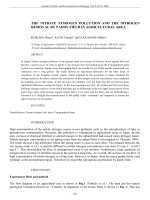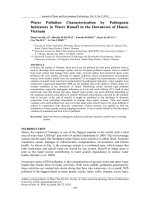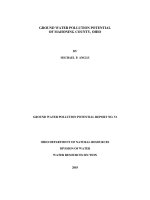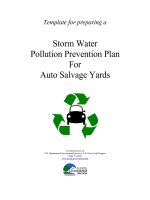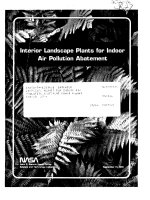Methodology for Integral Water Pollution Assessment within Agricultural Area docx
Bạn đang xem bản rút gọn của tài liệu. Xem và tải ngay bản đầy đủ của tài liệu tại đây (1.27 MB, 7 trang )
BALWOIS 2010 - Ohrid, Republic of Macedonia - 25, 29 May 2010
1
Methodology for Integral Water Pollution Assessment
within Agricultural Area
Jasna Piperski, Pavel Benka, Atila Bezdan, Atila Salvai
University of Novi Sad, Faculty of Agriculture, Serbia
Abstract
The main economy branch in the Province of Vojvodina is agriculture, which has significantly
influenced water quality of watercourses as well as groundwater. Both nonpoint and point source of
pollution are present in the form of agricultural runoff from arable land and point sources from farm
wastewater discharges. Pollution assessment stated by the EU Water Framework Directive requires
the application of integral approach. The paper presents a methodology for pollution assessment that
includes precise determination of the pollution sources and GIS mapping, monitoring and
quantification, modeling, and calculating Total Maximum Daily Load - TMDL values. Water quality
model QUAL2K was employed, while developed models were used for simulation of possible
scenarios. This kind of methodology was applied to the basin of drainage canal KC-III, a part of
Vrbas’s drainage system.
Key words: water quality, GIS, modeling, QUAL2K
Introduction
Region of Vojvodina is the most productive agricultural region in the Republic of Serbia and among
bigger in Europe. Arable land covers above 1.6 million ha, or 75% of its territory. Land husbandry,
farming and food processing industries are leading economy branches of the region. However, at the
same time these are also the most significant polluters of a dense hydrologic network consisting of
canals and rivers. Both nonpoint and point source of pollution are present in the form of agricultural
runoff from arable land and point sources from farm wastewater discharges. Pollution assessment
stated by the EU Water Framework Directive (Council Directive, 2000/60/EC) requires the application
of integral approach. Similarly, the Clean Water Act implemented by the US Environmental Protection
Agency requires calculating TMDL (Total Maximum Daily Load) value (USEPA, 1991, 1999). The main
idea of the concept is to determine concentration of polluting substance in a form of pollution load that
can be received by a water body, and at the same time to maintain quality within limits posed by water
quality standards. Both mentioned approaches recommend application of GIS and water quality
modeling. However, the problem arises from the fact that most of problems concerned to water quality
issues have its spatial dimension, and most of water quality models have weak link to users interface,
or any ability of spatial presentation of data. During various cases studies performed at the
Department for Water Resources, Faculty of Agriculture, Novi Sad, Serbia it has been emphasized the
need for integration of water quality modeling tools and GIS (Piperski, Salvai, 2008)
Unified presentation of data in GIS applications offers many advantages in cases when spatial
distribution of certain data of importance for watercourse water quality has to be illustrated, eg.
concentration of polluting substances, water abstractions, etc. Linking GIS database and water quality
models results in easier and more precise quantification of transport and transformation of pollutants
along a watercourse. Integral approach means considering important characteristics of a watercourse
its hydraulics characteristics, especially flow rate and water regime, and water quality. Data about
polluters could provide details on number and distribution of polluters along a watercourse, dominating
polluting substances, and their spreading and transformation. Such an approach contributes to more
precise calculation of type and pollution load, which a watercourse could receive, and still to maintain
satisfactory quality its, i.e. TMDL.
In the paper, a three-step methodology has been proposed aiming to facilitate efforts of water quality
research work, as well as satisfying requirements for integral approach. The methodology for pollution
assessment of water quality in watercourses includes precise determination of the pollution sources
and GIS mapping, monitoring and quantification of polluting substances, modeling, and calculating
TMDL values.
BALWOIS 2010 - Ohrid, Republic of Macedonia - 25, 29 May 2010
2
Methodology for integral management of water quality
of watercourses in Vojvodina
Water quality models have become advanced in describing dynamics in water environment and may
offer a large number of data. In general problems are recognized in presenting data in their
geographic surrounding. Besides, geographic processing of data of environment is similarly
developed, and as a result many Geographic Information Systems exist. However, despite the
mentioned, problems may arise in linking these two fields. Some general recommendations are that
on smaller watersheds use of the same data might be limited, because of the scale and minimal units
that are inserted into a map. In such situation important details may hidden, but still verification of
these data is possible. In general it is necessary to relay on the best and the most reliable data series.
Also, it is advisable to make a list of all potential sources of pollution, all watercourses from a
watershed before assessing pollution impact. Linking complex water quality models with GIS database
might ease decision making process, but also it their precision dose not have to justify demanded
efforts and resources. Application of detailed methods is the most convenient in following cases:
• When it is necessary of analyze runoff and pollution transport.
• Problems of water quality which require addressing short time issues (eg. days, hours), and
effects dependent on time.
• A Higher degree of precision and refined assessment, because of complexity of observed
watershed system, or for price of potential control (USEPA, 1999).
The problem of linking GIS and water quality modeling in not new, and during past few decades many
systems were designed in order to overcome this obstacle. US EPA uses system BASINS (Better
Assessment Science Integrating point & Non-point Sources) that is a multi-purpose environmental
analysis system which integrates a geographical information system (GIS), national watershed data,
and state-of-the-art environmental assessment and modeling tools into one convenient package
(USEPA, 2010).
Marsili-Libelli et al. (2001, 2002) have been working on solving the problem proposing
a technique, which would enable modeled data obtained from water quality model in Matlab (The
Maths Works Inc. USA) to be presented within the well-known GIS program as ArcView (ESRI Inc.
USA). Besides, linking program from QUAL family with GIS environment does not represent novelty,
since Marsili-Libelli et al. (2004) have achieved linking QUAL2E with GIS.
Each of existing attempts has its strengths and weaknesses. The proposed methodology was
designed in order to suit various requirements of investigating water quality in agricultural region in
Vojvodina. However, it could be applied to any other watersheds. The methodology (figure 1) consists
of three steps:
• Application of GIS technologies. GIS basis could be used to help in building cadastre of
polluters. It requires spatial geo-positioning of polluters, and accompanying database with
data on physical and chemical characteristics of polluting effluent substances. The database
also should contain data about water abstraction, and estimated pollution loads from non
point sources, i.e. arable land.
• Water quality modeling. QUAL2K, a complex water quality model, has been selected as a
tool that offers modeling and simulation of transport and transformation of nutrient that are
the most frequent polluters within agricultural area.
• Determining TMDL - Calculation of maximal pollution load which a watercourse can receive
and still to maintain satisfactory water quality.
BALWOIS 2010 - Ohrid, Republic of Macedonia - 25, 29 May 2010
3
Figure 1. Integration of GIS, water quality modeling and TMDL calculation
An example of application of the methodology is shown on a reach of a canal KC-III, heavily polluted
by effluents from a pig farm.
Material and methods
The canal KC-III is located near town of Vrbas, Backa district in Vojvodina, and is a part of the Vrbas
drainage system. The canal drains surrounding arable land and receives wastewater from the pig farm
"Farmacoop". Investigated reach stretches from the junction with Vrbas-Bezdan canal to 3,3km
upstream where effluents from lagoons of the pig farm are discharging into it. Research on water
quality and quantity was conducted by the Department for Water Management, faculty of Agriculture,
Novi Sad, Serbia, and was performed in 2006, 2008, and 2009. It was comprised of taking water
samples for determining major physical and chemical analyses. Canal water quality showed high
levels of pollution with organic material, while water turbidity was also significant. Besides, the
sedimentation of suspended material, resulted in forming of mud. The measurement also included
hydrometric measurements explained in details by Salvai and Bezdan (2008).
The obtained data were processes and modeled applying QUAL2K water quality model. The model is
one-dimensional, and assumes that the water in a stream is well-mixed vertically and laterally. It
employs steady state hydraulics, and uses a diel heat budget. Moreover, the model computes dial
water-quality kinetics, and simulates point and nonpoint loads and abstractions. Simulations of some
of the measured parameters of the canal KC-III could be found in the paper written by Salvai and
Bezdan (2008).
GIS software applied for the purpose of implementation of the methodology is capable of spatial
presentation of data. National coordinate system, Gauss-Krüger’s projection, within the 7
th
meridian
zone, was used in the process of designing layers, and a satellite image was used as a background.
Input data for GIS were divided into more categories: general spatial data, measured values on field,
and data on transport and transformation of pollution obtained after modeling using QUAL2K.
Categorization and limit values for examined parameters were taken after Regulation on Water
Classification (Official Gazette SRS, 5/68). TMDL values for some important polluting substances were
calculated according to the method proposed by US Environmental protection Agency in accordance
with the Clean Water Act of the USA (USEPA, 1999).
The methodology integrates existing approaches into a three step process, with a goal of sustainable
management of watercourses within an agricultural area.
Results and discussion
Model QUAL2K requires dividing modeled watercourse into segments. An output for one segment
represents an input to the downstream segment. The length of segments can be specified manually,
and for this modeling, it is set at around 200 m.
For GIS layers with location of taking samples for analyses of water quality, measured values of
parameters are inserted into an attribute table. Besides, results of hydrometric measurement from
BALWOIS 2010 - Ohrid, Republic of Macedonia - 25, 29 May 2010
4
corresponding attribute tables are linked to layers with their mapped locations. Figure 2 presents
illustration of results of hydrometric measurements in GIS application.
Figure 2. Illustration of results of hydrometric measurements in GIS environment
For the purpose of modeling QUAL2K divides the reach into segments. An output data are in a form of
an Excel tables as well as in charts. A link has been established between the Excel table generated
from QUAL2K and GIS layer’s attribute table. Common fields for both tables are distances in km,
starting from the middle of each segment (table 1). The connection enables map presentation of
spreading of polluting substance along the reach for measured and simulated values (figures 3, 4).
Table 1. Illustration of external table generated from QUAL2K
Field Type of data Unit Note
X(KM) * numeric km distance in km
COND_(UMHO numeric μS/cm conductivity
ISS_(MGD/L numeric mgD/L inorganic suspended solids
DO(MGO2/L) numeric mg/L dissolved oxygen
CBODS_(MGO numeric mgO
2
/L slowly reacting CBOD
CBODF_(MGO numeric mgO
2
/L fast reacting CBOD
NO(UGN/L) numeric μgN/L organic nitrogen
NH4(UGN/L) numeric μgN/L ammonia nitrogen
NO3(UGN/L) numeric μgN/L nitrate nitrogen
PO_(UGP/L) numeric μgP/L organic phosphorus
INORG_P_(U numeric μgP/L inorganic phosphorus
PHYTO_(UGA numeric μgA/L phytoplankton
DETRITUS_( numeric mgD/L detritus
PATHOGEN numeric cfu/100 ml pathogen
ALK numeric mgCaCO3/L alkalinity
PH numeric - pH
BOT_ALG_(G numeric gD/m2 bottom algae
TOC numeric mgC/L total organic carbon
TN numeric μgN/L total nitrogen
TP numeric μgP/L total phosphorus
TKN numeric μgN/L total kijeldahl nitrogen
TSS numeric mgD/L total suspended solids
CBODU numeric mgO
2
/L total CBOD
Bot Algae numeric mgA/m
2
bottom algae
NH3 numeric μgN/L ammonia
DO_SAT numeric mgO
2
/L dissolved oxygen saturation
PHSAT numeric - pH saturation
BALWOIS 2010 - Ohrid, Republic of Macedonia - 25, 29 May 2010
5
Figure 3. Illustration of water classes along the canal KC-III according to oxygen concentration,
calibration of the QUAL2K model based on measurements carried out in 2009
Figure 4. Illustration of water classes along the canal KC-III according to simulated oxygen
concentration in 2008
An output from the QUAL2K model is in a form of charts, which are presenting data of measured
values, as well as of simulated ones of spreading o pollution along the canal. On the charts on x-axis
represents distance in km, and y-axis concentration of a certain water quality parameter. GIS
application has a link to pdf files containing the charts, by connecting a GIS layer presented as an
attribute table with pdf form of a chart for chosen parameter from the attribute table. On the described
way it is possible to obtain data of water parameters for measured and simulated values for 2006,
2008, and 2009. Figure 5 illustrates chart presentation of results of QUAL2K simulations and viewed in
GIS environment.
BALWOIS 2010 - Ohrid, Republic of Macedonia - 25, 29 May 2010
6
Figure 5. Chart presentation of results of QUAL2K simulations viewed in GIS environment
GIS layers formed for the purpose of presenting data of the canal KC-III enable following:
• Map of the spatial position of the canal, major polluters, and potential users (in case of water
quality improvement).
• Layers with locations of sampling water for determining its quality; one layer for each year.
• Spatial presentation of locations where hydrometric measurements were preformed; one layer
for each year.
• Searching data on water quality. Each water quality parameter could be searched by selecting
symbols designating sampling location on the map, or by reading exact values from attribute
table.
• Searching data on hydrometric measurement by selecting symbols designating location on the
map, or by selecting exact measurement values in the attribute table.
• Joining layers of the same content (eg. of physical-chemical analysis) with data from different
years, results in obtaining values of parameters in time.
• Map presentation of measured and simulated values of certain chemical parameter indicating
pollution along the canal reach. Choosing a specific parameter from attribute table generates
thematic map where parts of the canal are differently colored according to changes of
concentration, where each color represents certain concentration range required by
standards.
Experiences from world, in using similar approaches, indicate a variety of possible applications. Some
of these applications are:
• Pollution control – It could be conducted during process of designing capacity of wastewater
treatment facilities, or changes in permissive pollution load which might vary due to changes
of flow rate of a watercourse etc.
• Risk assessment or consequence mitigation – It enables easier determining responsibility, or
assessing exposure to polluting substances.
• Reconstruction of history of pollution transport – This action might include both GIS and
modeling for determining time regime within which an event might take place, or which
polluters could reach dangerous levels of pollution on some reaches of a watercourse.
BALWOIS 2010 - Ohrid, Republic of Macedonia - 25, 29 May 2010
7
Conclusion
The three step methodology comprised of application of GIS, modeling and determining TMDL
presented in this paper, offers basis for integral water quality management in the hydrologic network in
Vojvodina region. Its goal is to satisfy needs of different users along canals and at the same time to
contribute to protection of the environment. GIS base watershed maps are useful, because of
geographic presentation of various points of interest, and priority areas with degraded water quality.
These are especially important in a process of forming cadastre of polluters for presentation of point
and non point source pollution. Linking GIS and water quality models like QUAL2K bring a new quality,
and it is map illustration of some processes along a watercourse, as well as calculation of TMDL
values. In broader sense, within economy, nature protection and other fields, the methodology enables
determining permissive pollution loads for each pollutant, by calculating TMDL values.
The methodology has been developed for the purpose of the research of water quality within
agricultural region of Vojvodina. Further development and improvement of more technical details
would contribute to a more user friendly software solutions that might become a useful tool for
decision makers within the region.
This methodology could be further applied on the management of freshwater water quality and the
cadastre of polluters in the Province of Vojvodina.
References
Council Directive 2000/60/EC of 23 October 2000 establishing a framework for Community action in
the field of water policy, Official Journal L 327/1, 22.12.2000., pp.1-72.
Marsili Libelli S., Caporali E, Arrighi S., Becattelli C., 2001: A georeferenced water quality model
Water Science and Technology 43 (7): 223 - 230.
Marsili Libelli S., Pacini, G., Barresi, C., Petti, E. Sinacori F., 2002: An interactive georeferenced
water quality model Hydroinformatics 2002: Proceedings of the Fifth International Conference on
Hydroinformatics, Cardiff, UK.
Marsili-Libelli S., Betti F., Cavalieri S., 2004: Introducing river modelling in the implementation of the
DPSIR scheme in the Water Framework Directive. Proc. 3rd IEMMS Conference, Osnabrück,
Germany.
Official Gazette SRS, 1968: Regulation on Water Classification, Official Gazette SRS, No. 5/68. (in
Serbian)
Piperski J., Salvai, A., 2008: Water Quality Models Application in Vojvodina’s Canal Network, Serbia,
BALWOIS 2008, Ohrid, R Macedonia 27- 31
th
, May 2008.
/>
Salvai, A. Bezdan, A., 2008: Water Quality Model QUAL2K in TMDL Development, BALWOIS 2008,
Ohrid, R Macedonia 27- 31
th
, May 2008. />1161.pdf
United States Environmental Protection Agency (US EPA), 1991: Guidance for Water
Qualitybased Decisions: The TMDL Process. EPA 440/4-91-001, Office of Water, Washington, DC.
United States Environmental Protection Agency ([US EPA), 1999: Protocol for developing nutrient
TMDL’s. EPA 841-B-99-007. Office of Water (4503F) United States Environmental Protection Agency,
Washington, DC. 135 pp.
United States Environmental Protection Agency (US EPA), 2010: BASINS
Retrieved: 24.02.2010.


